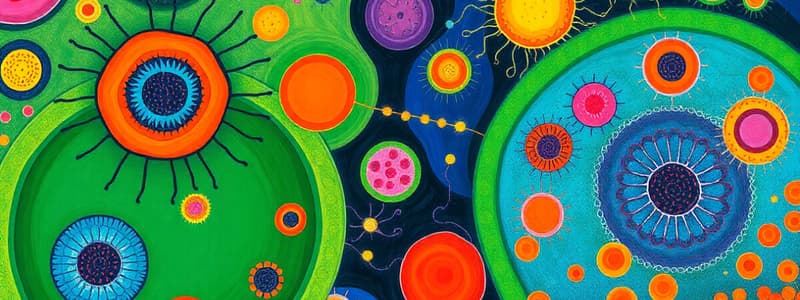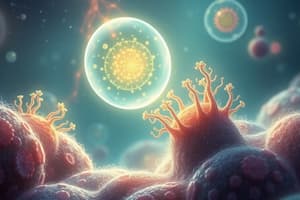Podcast
Questions and Answers
What pigment gives red algae their characteristic reddish color?
What pigment gives red algae their characteristic reddish color?
- Phycoerythrin (correct)
- Phycobilin
- Carotenoid
- Chlorophyll a
Which of the following is considered a sister group to land plants?
Which of the following is considered a sister group to land plants?
- Charophyta (correct)
- Chlorophyta
- Porphyra
- Red algae
What type of reproduction is observed in Chlamydomonas?
What type of reproduction is observed in Chlamydomonas?
- Binary fission only
- Both sexual and asexual reproduction (correct)
- Asexual reproduction only
- Only sexual reproduction
Which component is found in the cell wall of red algae?
Which component is found in the cell wall of red algae?
What is the primary photosynthetic pigment in green algae?
What is the primary photosynthetic pigment in green algae?
What is the primary characteristic of brown algae?
What is the primary characteristic of brown algae?
Which of the following statements about dinoflagellates is false?
Which of the following statements about dinoflagellates is false?
What role do apicomplexans play in the ecosystem?
What role do apicomplexans play in the ecosystem?
How does Plasmodium, the malaria-causing apicomplexan, complete its life cycle?
How does Plasmodium, the malaria-causing apicomplexan, complete its life cycle?
What type of cell wall do dinoflagellates have?
What type of cell wall do dinoflagellates have?
Which component is NOT found in apicomplexans?
Which component is NOT found in apicomplexans?
What makes brown algae distinct among algae?
What makes brown algae distinct among algae?
Which of the following factors contributes to dinoflagellate blooms?
Which of the following factors contributes to dinoflagellate blooms?
What process do ciliates undergo to produce genetic variation?
What process do ciliates undergo to produce genetic variation?
What is the microscopic structure that extends through the pores of foraminiferans called?
What is the microscopic structure that extends through the pores of foraminiferans called?
Which protist group is characterized by the presence of lobe-shaped pseudopodia?
Which protist group is characterized by the presence of lobe-shaped pseudopodia?
Which of the following protists is known to cause amoebic dysentery in humans?
Which of the following protists is known to cause amoebic dysentery in humans?
What material forms the tests of foraminiferans?
What material forms the tests of foraminiferans?
What do the micronuclei in ciliates primarily function in?
What do the micronuclei in ciliates primarily function in?
Which of the following organisms is a type of algae that shares a close evolutionary relationship with land plants?
Which of the following organisms is a type of algae that shares a close evolutionary relationship with land plants?
Which characteristic is common to gymnamoebas?
Which characteristic is common to gymnamoebas?
What type of movement is primarily used by amoebas to feed?
What type of movement is primarily used by amoebas to feed?
Which of the following is NOT a characteristic of Ciliates?
Which of the following is NOT a characteristic of Ciliates?
Which group of protists is known for their ability to photosynthesize and also absorb organic materials?
Which group of protists is known for their ability to photosynthesize and also absorb organic materials?
What primary organelle evolved from the endosymbiosis of a photosynthetic cyanobacterium?
What primary organelle evolved from the endosymbiosis of a photosynthetic cyanobacterium?
Which of the following best describes the function of kleptoplasty?
Which of the following best describes the function of kleptoplasty?
Which protist group includes Trypanosoma, which is known to cause sleeping sickness in humans?
Which protist group includes Trypanosoma, which is known to cause sleeping sickness in humans?
What type of reproduction do diatoms typically undergo?
What type of reproduction do diatoms typically undergo?
Which chemical compound is primarily found in the cell walls of diatoms?
Which chemical compound is primarily found in the cell walls of diatoms?
The grouping of Alveolata, Stramenopiles, and Rhizaria is referred to as what?
The grouping of Alveolata, Stramenopiles, and Rhizaria is referred to as what?
What is the defining characteristic of euglenids?
What is the defining characteristic of euglenids?
What is hypothesized to be the endosymbiont responsible for the secondary endosymbiosis of certain groups of protists?
What is hypothesized to be the endosymbiont responsible for the secondary endosymbiosis of certain groups of protists?
Which of the following storage polysaccharides is commonly found in protists?
Which of the following storage polysaccharides is commonly found in protists?
Which component is NOT typically found in the cell walls of protists?
Which component is NOT typically found in the cell walls of protists?
Which eukaryotic organelle is thought to have evolved from an aerobic prokaryote?
Which eukaryotic organelle is thought to have evolved from an aerobic prokaryote?
What type of nutrition do photoautotrophs in protists primarily rely on?
What type of nutrition do photoautotrophs in protists primarily rely on?
The characterizations of brown algae primarily involve which of the following?
The characterizations of brown algae primarily involve which of the following?
Flashcards are hidden until you start studying
Study Notes
Protists
- Most nutritionally diverse eukaryotes
- Photoautotrophs, with chloroplasts
- Chlorophylls a, b, c, and phycobilins
- Heterotrophs
- Absorbing organic molecules or ingesting larger food particles
- Mixotrophs
- Combine photosynthesis and heterotrophic nutrition
Endosymbiosis in Eukaryotic Evolution
- Nuclear DNA (likely) arose from a lineage within the Archaea
- Mitochondria evolved by endosymbiosis of an aerobic prokaryote
- Plastids evolved through endosymbiosis of a photosynthetic cyanobacterium
- Evidence suggests at least some protist diversity stems from endosymbiosis
Secondary Plastid Endosymbiosis
- Plastid evolved by endosymbiosis of another eukaryotic cell
- Secondary Plastids were derived from primary plastids
- Endosymbiosis of a eukaryote led to new plastids in eukaryotic cells
- Kleptoplasty occurs when an organism uses a stolen plastid from another organism.
- Example: The Sea Slug (phylum Mollusca)
- Kleptoplasty occurs when an organism uses a stolen plastid from another organism.
Excavata
- Diplomonads
- Parabasalids
- Euglenozoans
- Euglenids
- Kinetoplastids
Alveolates & SAR
- Dinoflagellates
- Apicomplexans
- Ciliates
- Stramenopiles
- Diatoms
- Golden algae
- Brown algae
- Oomycetes
- Rhizaria
- Chlorarachniophytes
- Forams
- Radiolarians
Unikonta
- Slime molds
- Gymnamoebas
- Entamoebas
- Nucleariids
- Fungi
- Choanoflagellates
- Animals
Protist Characteristics
- Storage Polysaccharide: α-1,4 Glucan or β-1,3 Glucan
- Plastid: Chlorophyll a, b, and/or c; Phycobilins; Plastid pigments absent
- Cell Wall: Cellulose, Silica, Protein or Absent
Key Terms
- Mixotroph
- Chlorophyll
- Phycobilins
- Mitochondrion
- Chloroplast
- Polysaccharide
- Glucan (glucose)
- Serial Endosymbiosis
- Primary Endosymbiosis
- Secondary Endosymbiosis
- Kleptoplasty
Euglenids
- Photoautotrophic unicellular organisms
- β-1,3 Glucan (storage polysaccharide)
- Plastid (chlorophyll a, chlorophyll b)
- Derived by secondary endosymbiosis from a green alga
- Cell Wall: Protein pellicle
- Crystalline rod
- Ring of microtubules
Kinetoplastids
- Single mitochondrion
- Organized mass of DNA called a kinetoplast
- Free-living consumers of prokaryotes in freshwater and marine ecosystems
- Trypanosoma causes sleeping sickness in humans
- Transmitted via Tsetse Fly
- Trypanosoma causes Chagas’ disease
- Transmitted via Reduviid (Triatomine) Bug
- Trypanosoma causes sleeping sickness in humans
SAR Alliance
- Stramenopiles, Alveolates, and Rhizaria
- DNA evidence supports a monophyletic group
- Sister clade (probably) with Stramenopiles and Alveolates
- Amoebas move and feed by filose (thread-like) pseudopodia
Diatoms
- Unicellular algae
- Unique two-part, glass-like wall of hydrated silica
- Reproduce asexually and occasionally sexually
- β-1,3 Glucan (storage polysaccharide)
- Plastid (chlorophyll a, chlorophyll c)
- Derived by secondary endosymbiosis from a red alga
- Cell Wall: Silica
Brown Algae
- Largest and most complex algae
- Multicellular, mostly marine
- “Seaweeds” and “kelps”
- β-1,3 Glucan (storage polysaccharide)
- Plastid (chlorophyll a, chlorophyll c)
- Derived by secondary endosymbiosis from a red alga
- Cell Wall: Cellulose
Dinoflagellates
- Mostly photoautotrophic unicells
- Two flagella
- α-1,4 Glucan (storage polysaccharide)
- Plastid (chlorophyll a, chlorophyll c)
- Derived by secondary endosymbiosis from a red alga
- Cell Wall: Cellulose
- Responsible for red tide “blooms”
- Cause Paralytic Shellfish Poisoning (PSP)
Apicomplexans
- Parasites of animals, causes human diseases
- Apex contains organelles for penetrating a host
- Nonphotosynthetic plastid: apicoplast
- Sexual and asexual stages requiring two hosts to complete their life cycle
- Plasmodium causes malaria
- Malaria parasite requires mosquitos and humans to complete its life cycle
- More than 200 million people contracted malaria in 2019
- More than 400,000 people died from malaria in 2019
- α-1,4 Glucan (storage polysaccharide)
- Apicoplast
- No pigments
- Cell Wall: None
Ciliates
- Use cilia for movement and feeding
- Large macronuclei and small micronuclei (dikaryotic)
- Micronuclei function during conjugation (sexual process)
- Reproduction by binary fission
- α-1,4 Glucan (storage polysaccharide)
- Plastid: None
- Cell Wall: None
Rhizarians
- Diverse group
- DNA similarities
- Amoebas move and feed by filose (thread-like) pseudopodia
- Forams and radiolarians
Forams
- Porous, generally multichambered shells (mostly calcium carbonate); called tests
- Filose pseudopodia extend through pores in the “test”
- Foram “tests” in marine sediments form an extensive fossil record
- α-1,4 Glucan (storage polysaccharide)
- Plastid: None
- Cell Wall: None (CaCO3 shells)
Amoebozoans
- Amoeba with lobe- or tube-shaped (lobose) pseudopodia
- Gymnamoebas, Entamoebas, and slime molds
- Scientists are still debating the relationship between Amoebozoans and Opisthokonts
Gymnamoebas
- Common unicellular amoebozoans
- Soil, freshwater and marine environments
- Heterotrophic and consume bacteria and protists
Entamoebas
- Parasites of vertebrates and some invertebrates
- Entamoeba histolytica causes amoebic dysentery in humans
- α-1,4 Glucan (storage polysaccharide)
- Plastid: None
- Cell Wall: None
Red Algae
- Reddish in color due to phycoerythrin (masks chlorophyll)
- Mostly multicellular, some are seaweeds
- The most abundant large algae in the tropics
- α-1,4 Glucan (storage polysaccharide)
- Plastid (chlorophyll a, phycobilins)
- Cell Wall: Cellulose
Green Algae
- Grass-green chloroplasts
- Plants are descended from them
- Chlorophyta and Charophyta
- Charophyta are the sister group to land plants (Embryophytes)
- Aka the Streptophyta
- α-1,4 Glucan (storage polysaccharide)
- Plastid (chlorophyll a, chlorophyll b)
- Cell Wall: Cellulose
Additional Key Terms
- Stramenopila
- Alveolata
- Alveoli
- Dinoflagellate
- Red Tide
- Plasmodium
- Sporozoite
- Merozoite
- Gametocyte
- Zygote
- Ciliata
- Paramecium
- Macronuclei
- Micronuclei
- Dikaryotic
- Diatom
- Silica
- Fossils
- Cellulose
- Chlorophyll a
- Chlorophyll c
- Lobose pseudopodia
- Gymnamoeba
- Entamoeba
- Filose pseudopodia
- Test
- Calcium carbonate
- Amoebozoa
- Chlamydomonas
- Zoospore
- Asexual Reproduction
- Fertilization
- Meiosis
- Charophyta
- Streptophyta
- Chlorophyta
Studying That Suits You
Use AI to generate personalized quizzes and flashcards to suit your learning preferences.




